人教新目标(Go for it)版八年级下 Unit 9 Have you ever been to a museum?教学设计 2
文档属性
| 名称 | 人教新目标(Go for it)版八年级下 Unit 9 Have you ever been to a museum?教学设计 2 | 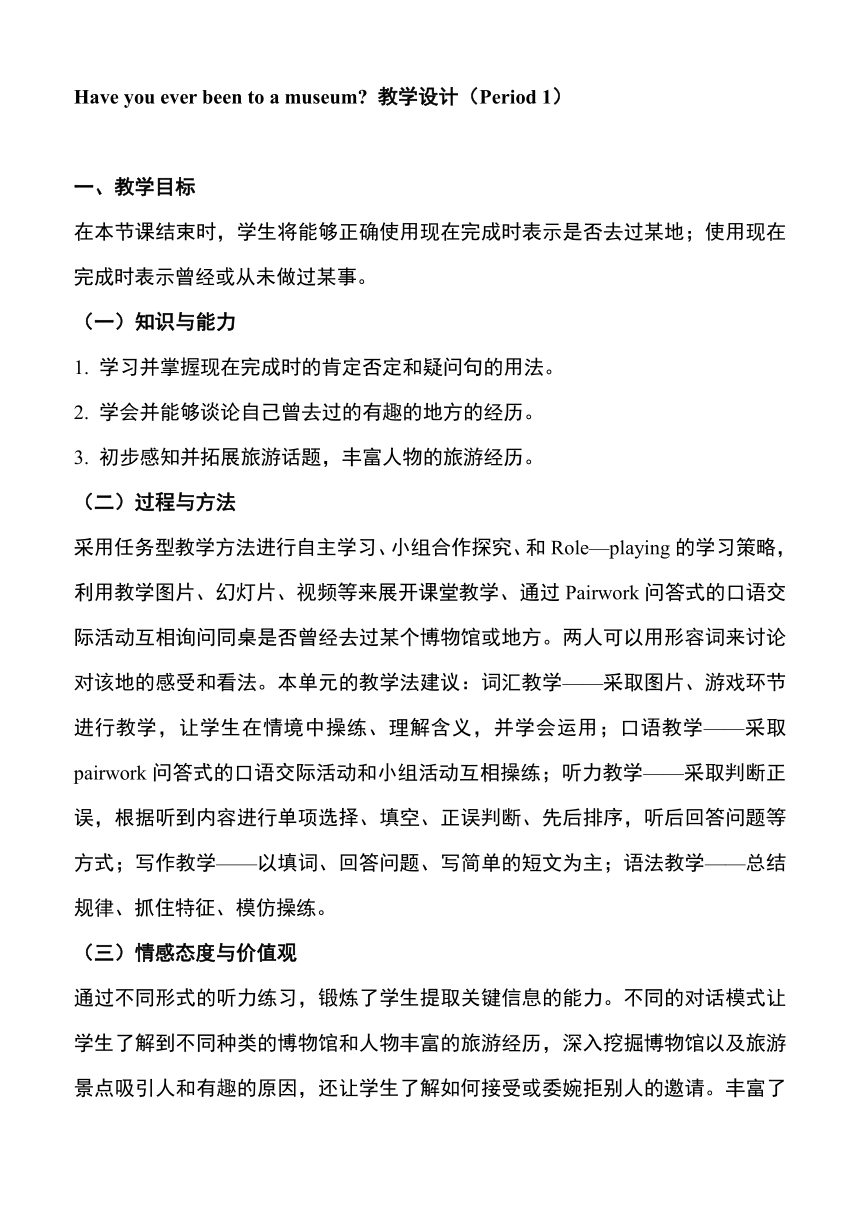 | |
| 格式 | doc | ||
| 文件大小 | 71.0KB | ||
| 资源类型 | 教案 | ||
| 版本资源 | 人教新目标(Go for it)版 | ||
| 科目 | 英语 | ||
| 更新时间 | 2022-01-25 12:39:53 | ||
图片预览

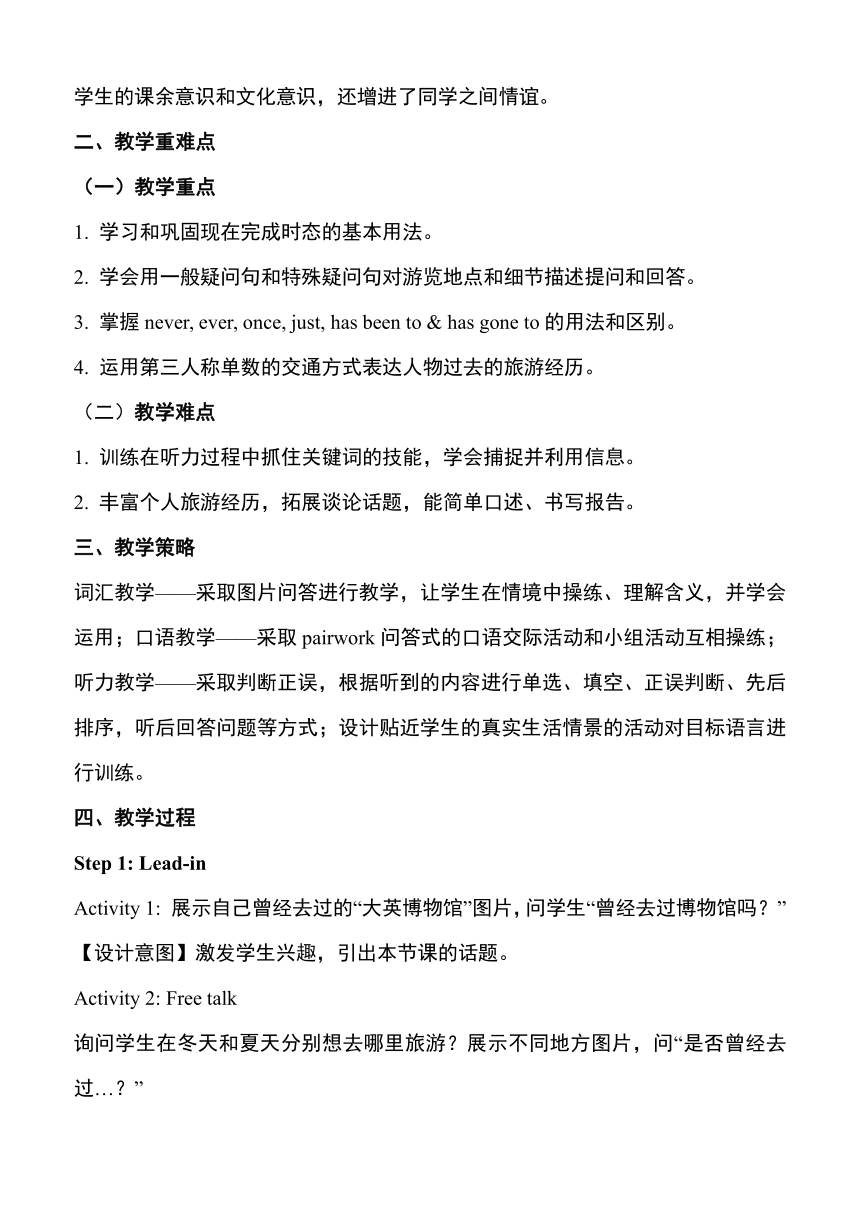
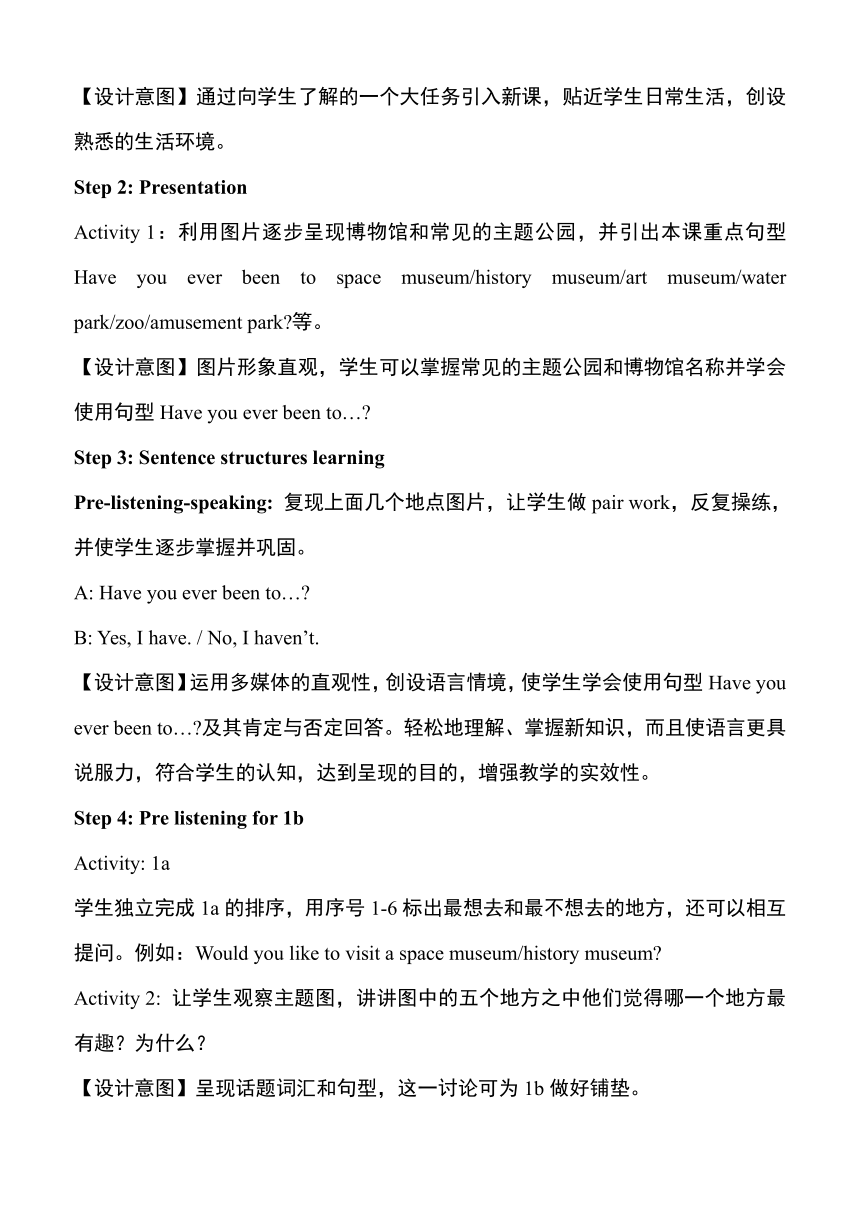
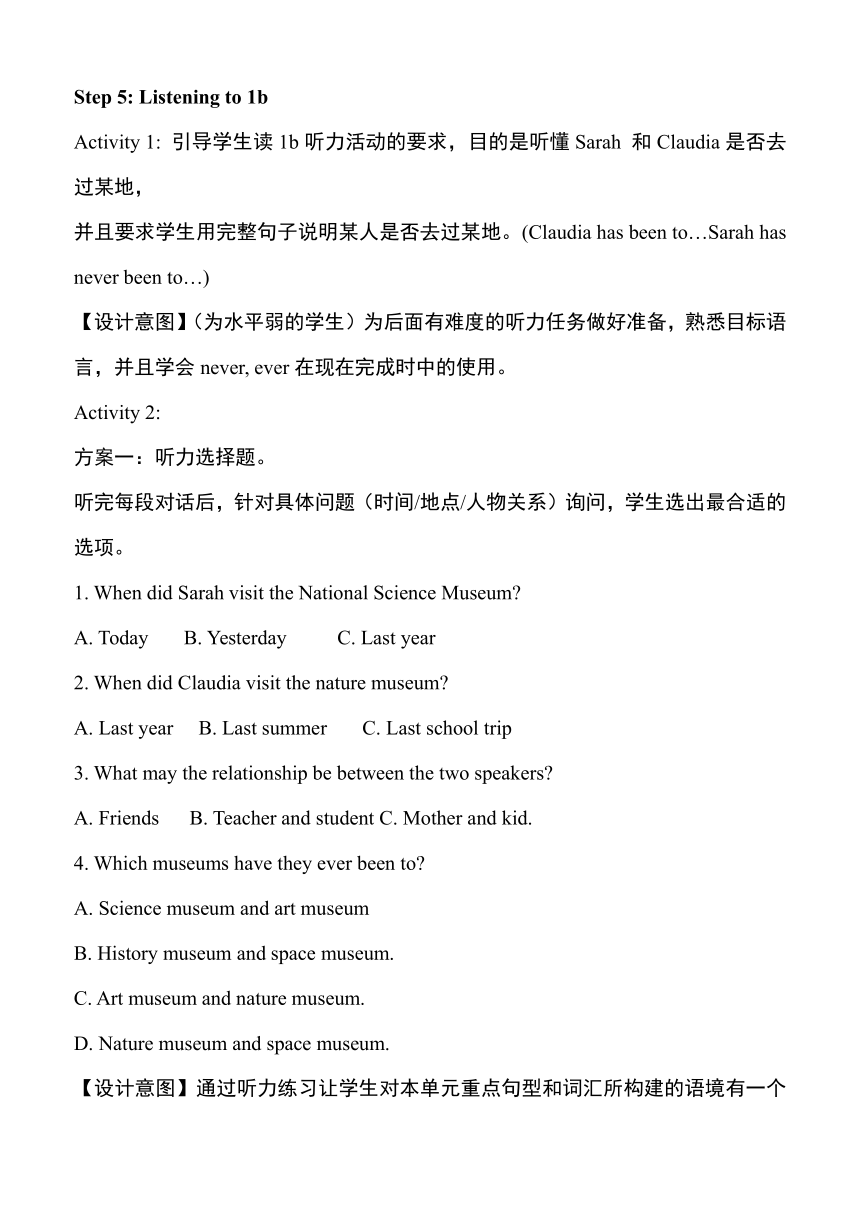
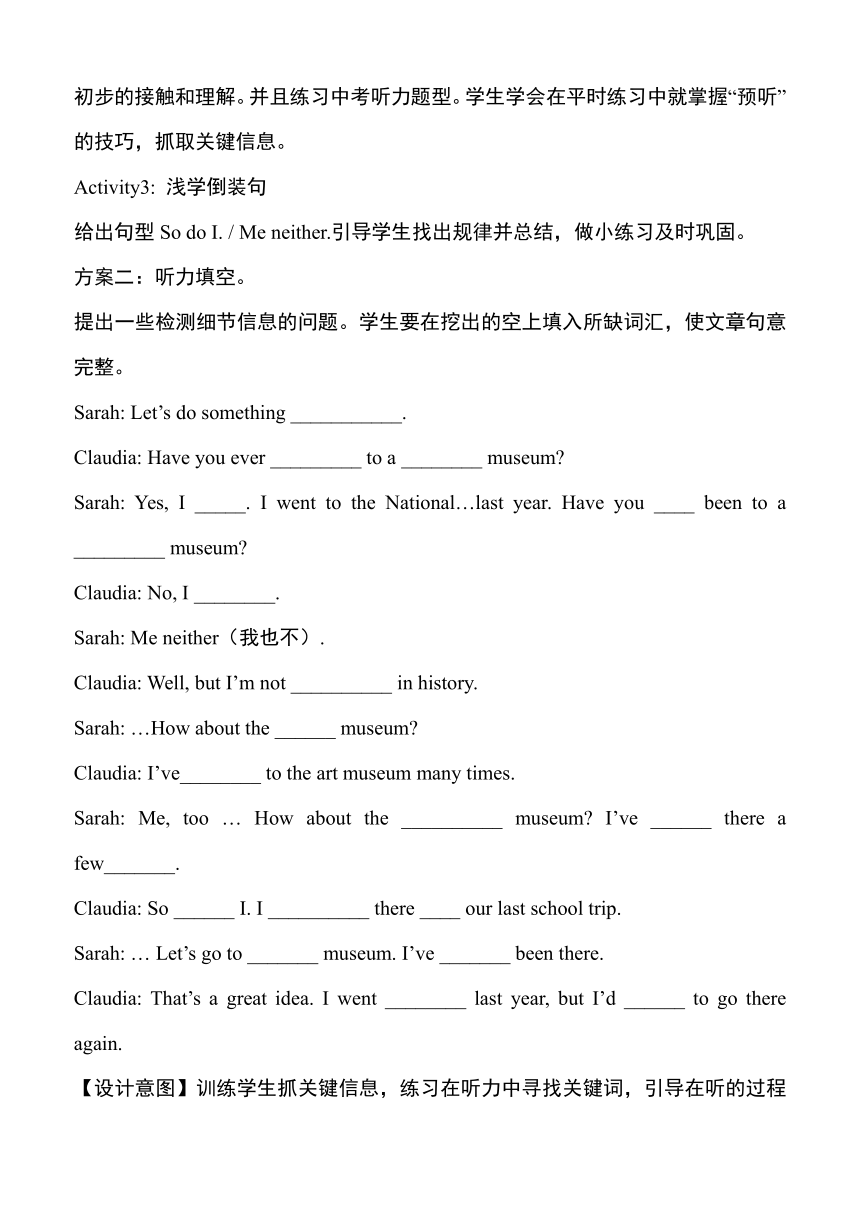
文档简介
Have you ever been to a museum 教学设计(Period 1)
一、教学目标
在本节课结束时,学生将能够正确使用现在完成时表示是否去过某地;使用现在完成时表示曾经或从未做过某事。
(一)知识与能力
1. 学习并掌握现在完成时的肯定否定和疑问句的用法。
2. 学会并能够谈论自己曾去过的有趣的地方的经历。
3. 初步感知并拓展旅游话题,丰富人物的旅游经历。
(二)过程与方法
采用任务型教学方法进行自主学习、小组合作探究、和Role—playing的学习策略,利用教学图片、幻灯片、视频等来展开课堂教学、通过Pairwork问答式的口语交际活动互相询问同桌是否曾经去过某个博物馆或地方。两人可以用形容词来讨论对该地的感受和看法。本单元的教学法建议:词汇教学——采取图片、游戏环节进行教学,让学生在情境中操练、理解含义,并学会运用;口语教学——采取pairwork问答式的口语交际活动和小组活动互相操练;听力教学——采取判断正误,根据听到内容进行单项选择、填空、正误判断、先后排序,听后回答问题等方式;写作教学——以填词、回答问题、写简单的短文为主;语法教学——总结规律、抓住特征、模仿操练。
(三)情感态度与价值观
通过不同形式的听力练习,锻炼了学生提取关键信息的能力。不同的对话模式让学生了解到不同种类的博物馆和人物丰富的旅游经历,深入挖掘博物馆以及旅游景点吸引人和有趣的原因,还让学生了解如何接受或委婉拒别人的邀请。丰富了学生的课余意识和文化意识,还增进了同学之间情谊。
二、教学重难点
(一)教学重点
1. 学习和巩固现在完成时态的基本用法。
2. 学会用一般疑问句和特殊疑问句对游览地点和细节描述提问和回答。
3. 掌握never, ever, once, just, has been to & has gone to的用法和区别。
4. 运用第三人称单数的交通方式表达人物过去的旅游经历。
(二)教学难点
1. 训练在听力过程中抓住关键词的技能,学会捕捉并利用信息。
2. 丰富个人旅游经历,拓展谈论话题,能简单口述、书写报告。
三、教学策略
词汇教学——采取图片问答进行教学,让学生在情境中操练、理解含义,并学会运用;口语教学——采取pairwork问答式的口语交际活动和小组活动互相操练;听力教学——采取判断正误,根据听到的内容进行单选、填空、正误判断、先后排序,听后回答问题等方式;设计贴近学生的真实生活情景的活动对目标语言进行训练。
四、教学过程
Step 1: Lead-in
Activity 1: 展示自己曾经去过的“大英博物馆”图片,问学生“曾经去过博物馆吗?”
【设计意图】激发学生兴趣,引出本节课的话题。
Activity 2: Free talk
询问学生在冬天和夏天分别想去哪里旅游?展示不同地方图片,问“是否曾经去过…?”
【设计意图】通过向学生了解的一个大任务引入新课,贴近学生日常生活,创设熟悉的生活环境。
Step 2: Presentation
Activity 1:利用图片逐步呈现博物馆和常见的主题公园,并引出本课重点句型Have you ever been to space museum/history museum/art museum/water park/zoo/amusement park 等。
【设计意图】图片形象直观,学生可以掌握常见的主题公园和博物馆名称并学会使用句型Have you ever been to…
Step 3: Sentence structures learning
Pre-listening-speaking: 复现上面几个地点图片,让学生做pair work,反复操练,并使学生逐步掌握并巩固。
A: Have you ever been to…
B: Yes, I have. / No, I haven’t.
【设计意图】运用多媒体的直观性,创设语言情境,使学生学会使用句型Have you ever been to… 及其肯定与否定回答。轻松地理解、掌握新知识,而且使语言更具说服力,符合学生的认知,达到呈现的目的,增强教学的实效性。
Step 4: Pre listening for 1b
Activity: 1a
学生独立完成1a的排序,用序号1-6标出最想去和最不想去的地方,还可以相互提问。例如:Would you like to visit a space museum/history museum
Activity 2: 让学生观察主题图,讲讲图中的五个地方之中他们觉得哪一个地方最有趣?为什么?
【设计意图】呈现话题词汇和句型,这一讨论可为1b做好铺垫。
Step 5: Listening to 1b
Activity 1: 引导学生读1b听力活动的要求,目的是听懂Sarah 和Claudia是否去过某地,
并且要求学生用完整句子说明某人是否去过某地。(Claudia has been to…Sarah has never been to…)
【设计意图】(为水平弱的学生)为后面有难度的听力任务做好准备,熟悉目标语言,并且学会never, ever在现在完成时中的使用。
Activity 2:
方案一:听力选择题。
听完每段对话后,针对具体问题(时间/地点/人物关系)询问,学生选出最合适的选项。
1. When did Sarah visit the National Science Museum
A. Today B. Yesterday C. Last year
2. When did Claudia visit the nature museum
A. Last year B. Last summer C. Last school trip
3. What may the relationship be between the two speakers
A. Friends B. Teacher and student C. Mother and kid.
4. Which museums have they ever been to
A. Science museum and art museum
B. History museum and space museum.
C. Art museum and nature museum.
D. Nature museum and space museum.
【设计意图】通过听力练习让学生对本单元重点句型和词汇所构建的语境有一个初步的接触和理解。并且练习中考听力题型。学生学会在平时练习中就掌握“预听”的技巧,抓取关键信息。
Activity3: 浅学倒装句
给出句型So do I. / Me neither.引导学生找出规律并总结,做小练习及时巩固。
方案二:听力填空。
提出一些检测细节信息的问题。学生要在挖出的空上填入所缺词汇,使文章句意完整。
Sarah: Let’s do something ___________.
Claudia: Have you ever _________ to a ________ museum
Sarah: Yes, I _____. I went to the National…last year. Have you ____ been to a _________ museum
Claudia: No, I ________.
Sarah: Me neither(我也不).
Claudia: Well, but I’m not __________ in history.
Sarah: …How about the ______ museum
Claudia: I’ve________ to the art museum many times.
Sarah: Me, too … How about the __________ museum I’ve ______ there a few_______.
Claudia: So ______ I. I __________ there ____ our last school trip.
Sarah: … Let’s go to _______ museum. I’ve _______ been there.
Claudia: That’s a great idea. I went ________ last year, but I’d ______ to go there again.
【设计意图】训练学生抓关键信息,练习在听力中寻找关键词,引导在听的过程中快速获取关键信息。
Step 6: Speaking Practice
Do 1c.
A: Let’s go somewhere different today.
B: OK. Where do you want to go
A: Have you ever been to the space museum
B: No, I haven’t. How about you
A: …
要求学生联系实际情况进行问答活动,完成简单的语言输出。
【设计意图】教师在黑板上呈现一些基本句型,帮助学生更好组织语言,巩固所学句型。
Step 7: Listening to 2a/2b
Activity1: Listen to 2a
观察2a地图,说说在地图上看到了哪些地方,讲出每个地点的方位后听对话,勾出关键地点名称。
【设计意图】综合复习以前学过的方位表达法。为后面有难度的听力做好语言上的铺垫。
Activity2: Listen to 2b: T/F判断(详见教材)。
三个对话分别是航空博物馆、游乐园和水上乐园,学生判断其中所提到的句子是否符合文意。听前有必要引导学生读懂每个句子。
【设计意图】以听力的方式引导学生在主题公园和博物馆的语境中继续学习本单元的目标语言。通过这种题型练习,训练学生着重听哪些信息,正确理解文意,对其中关键信息有识别的能力。
方案一:听力选择。(每听完一段对话后,针对具体问题询问,选出最合适的选项)
Conversation 1
( ) 1. Who has visited the space museum
A. Tina B. John C. Both Tina and John.
( ) 2. How are Tina and John going to the space museum
A. Take the train B. Take the bus C. Take the subway.
Conversation 2
( ) 3. How are they going to get to the amusement park
A. They will walk there B. They will take the bus C. They will ride the bikes.
( ) 4. Does Linda want to go to the there with Kim again
A. Yes, she does. B. No, she doesn’t. C. We don’t know.
Conversation 3
( ) 5. Where will Tom and Frank go at last
A. They will go to the water park.
B. They will go skating.
C. They will go to the River Park.
( ) 6. What’s Frank’s problem
A. He doesn’t have his bike.
B. He doesn’t have his skates.
C. He doesn’t have any money.
【设计意图】训练学生抓住关键词的能力和对二次正确信息矫正的鉴别力、敏感度。对以前学过的句型巩固:1. How are you going there(练习乘坐交通工具方式表达法)2. Does she …(第三人称单数回答)3. will do(一般将来时)4. 对具体问题进行分析和推断(What’s the problem)。
方案二:听后回答问题。
1. Has John ever been to the space museum
__________________________________.
2. Why does Linda think the amusement park fun
Because there were many __________ things ________ there.
3. Where is the amusement park
It’s ___________ Street, near the zoo.
4. Will Frank go to the water park with Tom Why
______, because he ________ have ________ money.
【设计意图】熟悉对话中的句式,练习重点形容词exciting,介词on,名词street等正确书写。
方案三:听力填写表格(图略)
三个表格左侧都给出关键词what, how to get there 进行提问,需要对右半部分的细节、事实捕捉信息。
【设计意图】中考听力题型的考察,训练学生对部分关键信息点的提取、对本节课所要掌握的重点单词和词组进行考察拼写。学生是否对ever, been拼写理解,复习动词borrow等词的熟练运用。
Step 7: Speaking practice
Do 2c.
除了谈论参观和游览过的地方外,还综合了交通方式的提问How are we going to get there 复习了交通方式的表达法。
A: Have you ever been to the space museum
B: Yes, I have. How about you
A: No, I haven’t.
B: Oh, it’s fantastic. Let’s go tomorrow.
A: OK. How are we going to get there
B: We can take the subway.
还可以自编新的对话:
I’d really like to go there again.
What bus do we take to get to…
There were so many…things to do there.
Neither have I.
Let’s go… instead.
There’s a great new place for…
巩固所学的人物旅游活动的句型,鼓励学生模仿使用听力材料中的句式,丰富对话内容。
【设计意图】让学生继续谈论听力中涉及的几种节目类型,但要使用自己的真实信息,也就是尝试用所学语言表达自己的真实想法,逐步从模仿语言过渡到运用语言。
Step 8:Listen and answer the questions
Activity1: Pre listening for 2d
对即将要听内容进行猜测(film museum and camping),Anna and Jill上周末都去了哪里?
Activity2: 阅读对话前,给学生提出问题,让他们带着问题进行阅读。
1. When did Anna go to the film museum
2. What does Jill love about the film museum
3. What did Jill learn about
4. What did Jill do on the weekend
5. Has Anna ever been camping
【设计意图】把话题内容从游览过的地方扩展到对某个地方更为具体的描述,引导学生在对话中加入一些细节信息,丰富谈话的内容。
Step 9: Consolidation
读对话,选择合适的词汇,并用其适当形式填空。完成Anna和Jill的相关信息填写。
(1)Interesting (2)camped (3)color movies (4)April
(5)last weekend (6)loves (7)never (8)inventions
Anna went to the film museum ______. She thinks it is really _____. She has _______ been camping. Jill went to the film museum in _______. She _______ all the old movie cameras, and she learned about the _______ that led to ________. On the weekend, Jill _______ in the mountains with some friends.
【设计意图】锻炼学生捕捉信息的能力。让学生体会两人在谈论旅游经历时所需语言在真实语境中如何使用,并为学生模仿语言、学会简单口头和书写报告提供了示范。
Step10: Role-play the conversation and homework
Ss talk about their own weekend with each other. And make a report of one’s own.
【设计意图】笔头巩固所学目标语言和红色字体。小组或同桌谈论对某个周末或假期旅游的经历(时间、地点、所做事情)等情节,有利于学生对现在完成时和一般过去时的写作能力的提高。
unit9 SectionA 3a--3c教学设计
1教学目标
1. Learn&Use the new words: invent, progress, rapid, unbelievable, unusual, encourage, improve, peaceful.
2. Learn&Use the new phrases:... as adj./adv.原级as... , in such a rapid way, encourage sb. to do.
3. Learn the reading strategy:read the first sentence of each paragraph for the main idea of the whole passage。
5. Learn to talk about the places Ss have been to in English.
6. Let Ss know the meaning of museums in their study and life and encourage Ss to visit museums in their free time.
( http: / / 1s1k.eduyun.cn / portal / 1s1k / sportal / index.jsp sdResIdCaseId=ff8080814e29d2a9014e3d55f3921773&t=show&sessionKey=O78UOKBd55khzPX5cbZN" \l "##### ) 2学情分析
该班为八年级学生,他们活泼,好奇心与求知欲望强。同时,经过该单元第一课时及本课的学案预习,他们已经对现在完成时、新词汇及博物馆相关话题有了初步了解,他们的语言学习热情也在逐步增加,为该课的学习做好了充足的语言准备。因此,通过本课的各种教学活动,帮助学生们更好地掌握重点词汇用法,引导学生们用英语介绍他们所搜集的相关博物馆的信息,鼓励每一位学生参与到课堂活动中去,使学生产生“跃跃欲试”的冲动,享受成功的喜悦。
3重点难点
学习重点:
(1)重点词汇:invent, progress, rapid, unbelievable, unusual, encourage, improve, peaceful.
(2)... as adj./adv.原级as... , in such a rapid way, encourage sb. to do结构。
学习难点:用英语介绍自己所了解的各种博物馆的信息。
4教学过程
教学活动
活动1【导入】pre-reading(Let’s go somewhere interesting today.)
1.Greet Ss and review the interesting places of China they learned yesterday.
2.Introduce today’s travel——different kinds of museums.
3.Facilitate Ss to list some museums they have traveled before.
4.Show pictures and let Ss guess what kind of museum it is. ( tea museum, computer museum and toilet museum)
5.Introduce the three students——Ken, Amy, Linlin, and their diaries about the tours of the three museums in 3a.
活动2【讲授】while-reading: Task1
1.Ask Ss. to read 3a quickly and find: Which museum have they been to Do matching Qs.
Qs.:
Ken Hangzhou National Tea Museum
Amy American Computer Museum
Linlin International Museum of Toilets
2.Check answers together and encourage Ss to conclude the reading strategy: read the first sentence of each paragraph for the main idea of the whole passage.
活动3【讲授】while-reading: Task2
3.Ask Ss. to work in groups and read 3a carefully for the 2nd time and do task2&3 on the papers.
Task 2 T&F Qs. and correct them.
( ) 1. American Computer Museum only has information about different computers there.
( ) 2. Ken thinks computers will do more work in the future.
( ) 3. The International Museum of Toilets is a very unusual museum.
( ) 4. The International Museum of Toilets has the most advanced(最发达的) toilets.
( ) 5. Watching the tea preparation is more enjoyable than drinking the tea itself.
( ) 6. Linlin didn’t know why her grandpa loved drinking tea and collecting tea sets until she visited the Hangzhou National Tea Museum.
活动4【讲授】while-reading: Task3
Task 3 Work in groups and read 3a carefully to find the words in the passage with the same meanings.
quiet__________ made________ uncommon__________
become better _________ make sth. better __________
quick________ difficult/not able to believe ___________
4. Invite some Ss to show their answers and check them together.
活动5【讲授】while-reading: Task4
5. Read aloud the passage again and facilitate Ss to retell: What are the most interesting things in each museum with mind maps as fast as they can.
E.g.: (1) American Computer Museum:
Q.1. What can we learn (information/technology)
Q.2. What do the old computers look like
Q.3. Is there any special computer What could it do
(2) International Museum of Toilets:
Q.1. What can we see
Q.2. Why did they build the museum (It tells us about________. ;It encourages ________).
(3)Hangzhou National Tea Museum:
Q.1. How is the museum
Q.2. What are the enjoyable things here
6. Explain the language points in this passage.
活动6【活动】After-reading: Let’s visit one museum that you lik
1. Work in groups and choose one museum they like best and use the information they have found to make a conversation between the guide and tourists. (T. walks around and helps Ss if necessary.)
2. Invite some groups to perform their dialogues and assess them together to choose the best guide.
3. Conclude the meaning of museums: Museums don’t only make our life colorful, but it can also open our minds and eyes.
活动7【作业】Homework
Write a diary about one of the three museums according to 3a and the conversations in this lesson.
unit9 SectionB 1a---1d教学设计
1教学目标
学习现在完成时,谈论过去的经历。掌握重点短语和句型。
2重点难点
重点短语:The Bird's Nest, The Palace Museum, the Great Wall,the Terracotta,Army.
重点句型:Have you tried Chinese food Have you seen the Terracotta Army
How long have you been in Beijing
3教学过程
教学活动
( http: / / 1s1k.eduyun.cn / portal / 1s1k / sportal / index.jsp sdResIdCaseId=ff8080814e0074ea014e24cdc81b44cb&t=show" \l "## ) 活动1【讲授】 Have you ever been to a museum
自主学习方案 1.自学生词,并记住拼读与拼写。
2.预习课本,找出重点短语及句子。
3.读记后完成自学导练作业。
课堂导学方案
Step 1 情景导入
T :Have you ever been to Beijing
S1: Yes,I have. T:OK, now please ask and answer like this in pairs
设计意图:通过师生问答和学生互答,让学生复习了现在完成时态,同时也练习了口语。
Step 2 完成教材11d的任务1a— 1d.
1.学生朗读表示地名的词组,教师纠正错误,然后用1a中的地名来练习对话,并且请几组学生来表演对话。
2.认真听一名中学生采访一名外籍学生的对话录音,标注出所听到的问题,完成后集体核对答案。
3.再认真听一遍录音,完成1c的表格,请学生展示答案,教师点拨。
4.认真听第三遍录音,整体感知对话内容。
5.小组内互相询问对方去过的地方或者是做过的事情。
eg Have you ever visited the old people in people's home
No,I haven't. what about you
I visited them last year.
Sounds great.I think I'm going to visit it next month.
.小结训练。
(1)— Where have you been (be) — I have been (be) to the library.
(2)— How many times have you been (be) to Beijing —Twice
(3)Daniel has never been (be) to Australia. He wants to go there with Millie.
(4)—I,ve bought a new MP4. —Where did you buy it (buy) —In a shopping mall near here.
(5)— Where is your mother — She has gone (go) to Shanghai with Uncle Li. She will come (come) back in three days.
(6)We haven’t finished (finish, not) our homework yet. Will you wait a minute
(7)John hasn’t come (come,not) yet. He will be back in a minute.
(8)Mr. Green often goes to America. In fact,he has been (be) there ten times.
(9)He has never traveled (travel, never) on a train in his life.
环节说明:通过这个环节提高了学生的听力水平并且学到了听力技巧,小结训练能让学生灵活运用现在完成 。
Step 3 问题探究
( B )—My car . Could you please give me a ride tomorrow
—I’m sorry I can’t. I’m London tomorrow morning
A.is new;leaving B.has broken down;leaving for C . broke;leaving for D.is expensive;leaving
由答语tomorrow morning知道是要用进行时表示将来时,leave for到某地去,故排除A,D,
break down 出故障,has broken down 相当于 is broken,所以选择答案B。
教学反思
本课时可帮助学生了解中国一些著名景点的英文名称,通过多听多读,讲练结合,既帮助学生增长了见识,也巩固了现在完成时的知识
Unit9SectionB Reading教学设计
1教学目标
知识目标:1. 初步了解现在完成时态。
2. 认识了解Singapore.
能力目标:发展学生快速阅读并归纳总结的能力,以及能记下要点概述全文的能力;训练学生阅读技能。
情感目标:通过本节课,激发学生对生态环境的关注和爱护,延伸到对家乡的热爱。
2学情分析
这是本单元第四课时,可是学生是第一次接触,所以我把重点放在如何在最快的时间内理解文章的内容并回答相应的问题。而且学生层次不同,我要照顾更多的基础不好的学生,所以设计问题时相对比较简单。
3重点难点
教学重点
1. Key phrases :take a holiday, three quarters, wake up, all year round. have been to +sp
2. Understand the passage correctly. Learn bout the background language of Singapore.
教学难点
Write some sentences correctly using the target language.
4教学过程
教学活动
( http: / / 1s1k.eduyun.cn / portal / 1s1k / sportal / index.jsp sdResIdCaseId=ff8080814cf994a3014d04adaeb97df0&t=show&sessionKey=eaoS1CdVlNqcytKi6Pww" \l "## ) 活动1【活动】一、问候语
Step 1. Greeting
1. Ask the students ,“Do you like Kashgar ”Show some pictures about Kashgar.
活动2【导入】二、导入
引入主题“Today I will take you to the Singapore” Have you ever been there before ” We’ll know more about Singapore after reading .
Introduce some key words and phrases.
( http: / / 1s1k.eduyun.cn / portal / 1s1k / sportal / index.jsp sdResIdCaseId=ff8080814cf994a3014d04adaeb97df0&t=show&sessionKey=eaoS1CdVlNqcytKi6Pww" \l "## ) 活动3【讲授】三、讲授语
Step 2. Pre-reading
Find out the main idea after the first reading.
Step 3. While reading
Read each paragraph ,and try to answer some questions .
A.1. Where is Singapore
2. What language do people speak in Singapore
3. Why can we speak Chinese in Singapore
B.1. What kind of Chinese food can we find in Singapore
2. What kinds of new food can we find
C.Try to fill in the blanks.
D.1. How is the weather in Singapore Why
2. When can we go to Singapore
Step4. After reading.
1. Read quickly , try to finish 2c
2. Retell the article
3. Let’s make a list of facts about Singapore.
( http: / / 1s1k.eduyun.cn / portal / 1s1k / sportal / index.jsp sdResIdCaseId=ff8080814cf994a3014d04adaeb97df0&t=show&sessionKey=eaoS1CdVlNqcytKi6Pww" \l "## ) 活动4【测试】四、总结
Step 5: Summary.
This class we have learnt a reading passage about Singapore. It’s one of the most beautiful countries in the world. Do you think so
xinjiang is also a beautiful and wonderwul place for travel.
( http: / / 1s1k.eduyun.cn / portal / 1s1k / sportal / index.jsp sdResIdCaseId=ff8080814cf994a3014d04adaeb97df0&t=show&sessionKey=eaoS1CdVlNqcytKi6Pww" \l "## ) 活动5【作业】五、布置作业
1.认真阅读,并完成课后题2d;
2. 用简单的图案列一个关于你的家乡的事实清单,并将你的得意之作装进成长记录带里。
( http: / / 1s1k.eduyun.cn / portal / 1s1k / sportal / index.jsp sdResIdCaseId=ff8080814cf994a3014d04adaeb97df0&t=show&sessionKey=eaoS1CdVlNqcytKi6Pww" \l "## ) 活动6【活动】六、评价
Step 7: Evaluation
选出本堂课最佳合作小组,预习达人,最美英语
一、教学目标
在本节课结束时,学生将能够正确使用现在完成时表示是否去过某地;使用现在完成时表示曾经或从未做过某事。
(一)知识与能力
1. 学习并掌握现在完成时的肯定否定和疑问句的用法。
2. 学会并能够谈论自己曾去过的有趣的地方的经历。
3. 初步感知并拓展旅游话题,丰富人物的旅游经历。
(二)过程与方法
采用任务型教学方法进行自主学习、小组合作探究、和Role—playing的学习策略,利用教学图片、幻灯片、视频等来展开课堂教学、通过Pairwork问答式的口语交际活动互相询问同桌是否曾经去过某个博物馆或地方。两人可以用形容词来讨论对该地的感受和看法。本单元的教学法建议:词汇教学——采取图片、游戏环节进行教学,让学生在情境中操练、理解含义,并学会运用;口语教学——采取pairwork问答式的口语交际活动和小组活动互相操练;听力教学——采取判断正误,根据听到内容进行单项选择、填空、正误判断、先后排序,听后回答问题等方式;写作教学——以填词、回答问题、写简单的短文为主;语法教学——总结规律、抓住特征、模仿操练。
(三)情感态度与价值观
通过不同形式的听力练习,锻炼了学生提取关键信息的能力。不同的对话模式让学生了解到不同种类的博物馆和人物丰富的旅游经历,深入挖掘博物馆以及旅游景点吸引人和有趣的原因,还让学生了解如何接受或委婉拒别人的邀请。丰富了学生的课余意识和文化意识,还增进了同学之间情谊。
二、教学重难点
(一)教学重点
1. 学习和巩固现在完成时态的基本用法。
2. 学会用一般疑问句和特殊疑问句对游览地点和细节描述提问和回答。
3. 掌握never, ever, once, just, has been to & has gone to的用法和区别。
4. 运用第三人称单数的交通方式表达人物过去的旅游经历。
(二)教学难点
1. 训练在听力过程中抓住关键词的技能,学会捕捉并利用信息。
2. 丰富个人旅游经历,拓展谈论话题,能简单口述、书写报告。
三、教学策略
词汇教学——采取图片问答进行教学,让学生在情境中操练、理解含义,并学会运用;口语教学——采取pairwork问答式的口语交际活动和小组活动互相操练;听力教学——采取判断正误,根据听到的内容进行单选、填空、正误判断、先后排序,听后回答问题等方式;设计贴近学生的真实生活情景的活动对目标语言进行训练。
四、教学过程
Step 1: Lead-in
Activity 1: 展示自己曾经去过的“大英博物馆”图片,问学生“曾经去过博物馆吗?”
【设计意图】激发学生兴趣,引出本节课的话题。
Activity 2: Free talk
询问学生在冬天和夏天分别想去哪里旅游?展示不同地方图片,问“是否曾经去过…?”
【设计意图】通过向学生了解的一个大任务引入新课,贴近学生日常生活,创设熟悉的生活环境。
Step 2: Presentation
Activity 1:利用图片逐步呈现博物馆和常见的主题公园,并引出本课重点句型Have you ever been to space museum/history museum/art museum/water park/zoo/amusement park 等。
【设计意图】图片形象直观,学生可以掌握常见的主题公园和博物馆名称并学会使用句型Have you ever been to…
Step 3: Sentence structures learning
Pre-listening-speaking: 复现上面几个地点图片,让学生做pair work,反复操练,并使学生逐步掌握并巩固。
A: Have you ever been to…
B: Yes, I have. / No, I haven’t.
【设计意图】运用多媒体的直观性,创设语言情境,使学生学会使用句型Have you ever been to… 及其肯定与否定回答。轻松地理解、掌握新知识,而且使语言更具说服力,符合学生的认知,达到呈现的目的,增强教学的实效性。
Step 4: Pre listening for 1b
Activity: 1a
学生独立完成1a的排序,用序号1-6标出最想去和最不想去的地方,还可以相互提问。例如:Would you like to visit a space museum/history museum
Activity 2: 让学生观察主题图,讲讲图中的五个地方之中他们觉得哪一个地方最有趣?为什么?
【设计意图】呈现话题词汇和句型,这一讨论可为1b做好铺垫。
Step 5: Listening to 1b
Activity 1: 引导学生读1b听力活动的要求,目的是听懂Sarah 和Claudia是否去过某地,
并且要求学生用完整句子说明某人是否去过某地。(Claudia has been to…Sarah has never been to…)
【设计意图】(为水平弱的学生)为后面有难度的听力任务做好准备,熟悉目标语言,并且学会never, ever在现在完成时中的使用。
Activity 2:
方案一:听力选择题。
听完每段对话后,针对具体问题(时间/地点/人物关系)询问,学生选出最合适的选项。
1. When did Sarah visit the National Science Museum
A. Today B. Yesterday C. Last year
2. When did Claudia visit the nature museum
A. Last year B. Last summer C. Last school trip
3. What may the relationship be between the two speakers
A. Friends B. Teacher and student C. Mother and kid.
4. Which museums have they ever been to
A. Science museum and art museum
B. History museum and space museum.
C. Art museum and nature museum.
D. Nature museum and space museum.
【设计意图】通过听力练习让学生对本单元重点句型和词汇所构建的语境有一个初步的接触和理解。并且练习中考听力题型。学生学会在平时练习中就掌握“预听”的技巧,抓取关键信息。
Activity3: 浅学倒装句
给出句型So do I. / Me neither.引导学生找出规律并总结,做小练习及时巩固。
方案二:听力填空。
提出一些检测细节信息的问题。学生要在挖出的空上填入所缺词汇,使文章句意完整。
Sarah: Let’s do something ___________.
Claudia: Have you ever _________ to a ________ museum
Sarah: Yes, I _____. I went to the National…last year. Have you ____ been to a _________ museum
Claudia: No, I ________.
Sarah: Me neither(我也不).
Claudia: Well, but I’m not __________ in history.
Sarah: …How about the ______ museum
Claudia: I’ve________ to the art museum many times.
Sarah: Me, too … How about the __________ museum I’ve ______ there a few_______.
Claudia: So ______ I. I __________ there ____ our last school trip.
Sarah: … Let’s go to _______ museum. I’ve _______ been there.
Claudia: That’s a great idea. I went ________ last year, but I’d ______ to go there again.
【设计意图】训练学生抓关键信息,练习在听力中寻找关键词,引导在听的过程中快速获取关键信息。
Step 6: Speaking Practice
Do 1c.
A: Let’s go somewhere different today.
B: OK. Where do you want to go
A: Have you ever been to the space museum
B: No, I haven’t. How about you
A: …
要求学生联系实际情况进行问答活动,完成简单的语言输出。
【设计意图】教师在黑板上呈现一些基本句型,帮助学生更好组织语言,巩固所学句型。
Step 7: Listening to 2a/2b
Activity1: Listen to 2a
观察2a地图,说说在地图上看到了哪些地方,讲出每个地点的方位后听对话,勾出关键地点名称。
【设计意图】综合复习以前学过的方位表达法。为后面有难度的听力做好语言上的铺垫。
Activity2: Listen to 2b: T/F判断(详见教材)。
三个对话分别是航空博物馆、游乐园和水上乐园,学生判断其中所提到的句子是否符合文意。听前有必要引导学生读懂每个句子。
【设计意图】以听力的方式引导学生在主题公园和博物馆的语境中继续学习本单元的目标语言。通过这种题型练习,训练学生着重听哪些信息,正确理解文意,对其中关键信息有识别的能力。
方案一:听力选择。(每听完一段对话后,针对具体问题询问,选出最合适的选项)
Conversation 1
( ) 1. Who has visited the space museum
A. Tina B. John C. Both Tina and John.
( ) 2. How are Tina and John going to the space museum
A. Take the train B. Take the bus C. Take the subway.
Conversation 2
( ) 3. How are they going to get to the amusement park
A. They will walk there B. They will take the bus C. They will ride the bikes.
( ) 4. Does Linda want to go to the there with Kim again
A. Yes, she does. B. No, she doesn’t. C. We don’t know.
Conversation 3
( ) 5. Where will Tom and Frank go at last
A. They will go to the water park.
B. They will go skating.
C. They will go to the River Park.
( ) 6. What’s Frank’s problem
A. He doesn’t have his bike.
B. He doesn’t have his skates.
C. He doesn’t have any money.
【设计意图】训练学生抓住关键词的能力和对二次正确信息矫正的鉴别力、敏感度。对以前学过的句型巩固:1. How are you going there(练习乘坐交通工具方式表达法)2. Does she …(第三人称单数回答)3. will do(一般将来时)4. 对具体问题进行分析和推断(What’s the problem)。
方案二:听后回答问题。
1. Has John ever been to the space museum
__________________________________.
2. Why does Linda think the amusement park fun
Because there were many __________ things ________ there.
3. Where is the amusement park
It’s ___________ Street, near the zoo.
4. Will Frank go to the water park with Tom Why
______, because he ________ have ________ money.
【设计意图】熟悉对话中的句式,练习重点形容词exciting,介词on,名词street等正确书写。
方案三:听力填写表格(图略)
三个表格左侧都给出关键词what, how to get there 进行提问,需要对右半部分的细节、事实捕捉信息。
【设计意图】中考听力题型的考察,训练学生对部分关键信息点的提取、对本节课所要掌握的重点单词和词组进行考察拼写。学生是否对ever, been拼写理解,复习动词borrow等词的熟练运用。
Step 7: Speaking practice
Do 2c.
除了谈论参观和游览过的地方外,还综合了交通方式的提问How are we going to get there 复习了交通方式的表达法。
A: Have you ever been to the space museum
B: Yes, I have. How about you
A: No, I haven’t.
B: Oh, it’s fantastic. Let’s go tomorrow.
A: OK. How are we going to get there
B: We can take the subway.
还可以自编新的对话:
I’d really like to go there again.
What bus do we take to get to…
There were so many…things to do there.
Neither have I.
Let’s go… instead.
There’s a great new place for…
巩固所学的人物旅游活动的句型,鼓励学生模仿使用听力材料中的句式,丰富对话内容。
【设计意图】让学生继续谈论听力中涉及的几种节目类型,但要使用自己的真实信息,也就是尝试用所学语言表达自己的真实想法,逐步从模仿语言过渡到运用语言。
Step 8:Listen and answer the questions
Activity1: Pre listening for 2d
对即将要听内容进行猜测(film museum and camping),Anna and Jill上周末都去了哪里?
Activity2: 阅读对话前,给学生提出问题,让他们带着问题进行阅读。
1. When did Anna go to the film museum
2. What does Jill love about the film museum
3. What did Jill learn about
4. What did Jill do on the weekend
5. Has Anna ever been camping
【设计意图】把话题内容从游览过的地方扩展到对某个地方更为具体的描述,引导学生在对话中加入一些细节信息,丰富谈话的内容。
Step 9: Consolidation
读对话,选择合适的词汇,并用其适当形式填空。完成Anna和Jill的相关信息填写。
(1)Interesting (2)camped (3)color movies (4)April
(5)last weekend (6)loves (7)never (8)inventions
Anna went to the film museum ______. She thinks it is really _____. She has _______ been camping. Jill went to the film museum in _______. She _______ all the old movie cameras, and she learned about the _______ that led to ________. On the weekend, Jill _______ in the mountains with some friends.
【设计意图】锻炼学生捕捉信息的能力。让学生体会两人在谈论旅游经历时所需语言在真实语境中如何使用,并为学生模仿语言、学会简单口头和书写报告提供了示范。
Step10: Role-play the conversation and homework
Ss talk about their own weekend with each other. And make a report of one’s own.
【设计意图】笔头巩固所学目标语言和红色字体。小组或同桌谈论对某个周末或假期旅游的经历(时间、地点、所做事情)等情节,有利于学生对现在完成时和一般过去时的写作能力的提高。
unit9 SectionA 3a--3c教学设计
1教学目标
1. Learn&Use the new words: invent, progress, rapid, unbelievable, unusual, encourage, improve, peaceful.
2. Learn&Use the new phrases:... as adj./adv.原级as... , in such a rapid way, encourage sb. to do.
3. Learn the reading strategy:read the first sentence of each paragraph for the main idea of the whole passage。
5. Learn to talk about the places Ss have been to in English.
6. Let Ss know the meaning of museums in their study and life and encourage Ss to visit museums in their free time.
( http: / / 1s1k.eduyun.cn / portal / 1s1k / sportal / index.jsp sdResIdCaseId=ff8080814e29d2a9014e3d55f3921773&t=show&sessionKey=O78UOKBd55khzPX5cbZN" \l "##### ) 2学情分析
该班为八年级学生,他们活泼,好奇心与求知欲望强。同时,经过该单元第一课时及本课的学案预习,他们已经对现在完成时、新词汇及博物馆相关话题有了初步了解,他们的语言学习热情也在逐步增加,为该课的学习做好了充足的语言准备。因此,通过本课的各种教学活动,帮助学生们更好地掌握重点词汇用法,引导学生们用英语介绍他们所搜集的相关博物馆的信息,鼓励每一位学生参与到课堂活动中去,使学生产生“跃跃欲试”的冲动,享受成功的喜悦。
3重点难点
学习重点:
(1)重点词汇:invent, progress, rapid, unbelievable, unusual, encourage, improve, peaceful.
(2)... as adj./adv.原级as... , in such a rapid way, encourage sb. to do结构。
学习难点:用英语介绍自己所了解的各种博物馆的信息。
4教学过程
教学活动
活动1【导入】pre-reading(Let’s go somewhere interesting today.)
1.Greet Ss and review the interesting places of China they learned yesterday.
2.Introduce today’s travel——different kinds of museums.
3.Facilitate Ss to list some museums they have traveled before.
4.Show pictures and let Ss guess what kind of museum it is. ( tea museum, computer museum and toilet museum)
5.Introduce the three students——Ken, Amy, Linlin, and their diaries about the tours of the three museums in 3a.
活动2【讲授】while-reading: Task1
1.Ask Ss. to read 3a quickly and find: Which museum have they been to Do matching Qs.
Qs.:
Ken Hangzhou National Tea Museum
Amy American Computer Museum
Linlin International Museum of Toilets
2.Check answers together and encourage Ss to conclude the reading strategy: read the first sentence of each paragraph for the main idea of the whole passage.
活动3【讲授】while-reading: Task2
3.Ask Ss. to work in groups and read 3a carefully for the 2nd time and do task2&3 on the papers.
Task 2 T&F Qs. and correct them.
( ) 1. American Computer Museum only has information about different computers there.
( ) 2. Ken thinks computers will do more work in the future.
( ) 3. The International Museum of Toilets is a very unusual museum.
( ) 4. The International Museum of Toilets has the most advanced(最发达的) toilets.
( ) 5. Watching the tea preparation is more enjoyable than drinking the tea itself.
( ) 6. Linlin didn’t know why her grandpa loved drinking tea and collecting tea sets until she visited the Hangzhou National Tea Museum.
活动4【讲授】while-reading: Task3
Task 3 Work in groups and read 3a carefully to find the words in the passage with the same meanings.
quiet__________ made________ uncommon__________
become better _________ make sth. better __________
quick________ difficult/not able to believe ___________
4. Invite some Ss to show their answers and check them together.
活动5【讲授】while-reading: Task4
5. Read aloud the passage again and facilitate Ss to retell: What are the most interesting things in each museum with mind maps as fast as they can.
E.g.: (1) American Computer Museum:
Q.1. What can we learn (information/technology)
Q.2. What do the old computers look like
Q.3. Is there any special computer What could it do
(2) International Museum of Toilets:
Q.1. What can we see
Q.2. Why did they build the museum (It tells us about________. ;It encourages ________).
(3)Hangzhou National Tea Museum:
Q.1. How is the museum
Q.2. What are the enjoyable things here
6. Explain the language points in this passage.
活动6【活动】After-reading: Let’s visit one museum that you lik
1. Work in groups and choose one museum they like best and use the information they have found to make a conversation between the guide and tourists. (T. walks around and helps Ss if necessary.)
2. Invite some groups to perform their dialogues and assess them together to choose the best guide.
3. Conclude the meaning of museums: Museums don’t only make our life colorful, but it can also open our minds and eyes.
活动7【作业】Homework
Write a diary about one of the three museums according to 3a and the conversations in this lesson.
unit9 SectionB 1a---1d教学设计
1教学目标
学习现在完成时,谈论过去的经历。掌握重点短语和句型。
2重点难点
重点短语:The Bird's Nest, The Palace Museum, the Great Wall,the Terracotta,Army.
重点句型:Have you tried Chinese food Have you seen the Terracotta Army
How long have you been in Beijing
3教学过程
教学活动
( http: / / 1s1k.eduyun.cn / portal / 1s1k / sportal / index.jsp sdResIdCaseId=ff8080814e0074ea014e24cdc81b44cb&t=show" \l "## ) 活动1【讲授】 Have you ever been to a museum
自主学习方案 1.自学生词,并记住拼读与拼写。
2.预习课本,找出重点短语及句子。
3.读记后完成自学导练作业。
课堂导学方案
Step 1 情景导入
T :Have you ever been to Beijing
S1: Yes,I have. T:OK, now please ask and answer like this in pairs
设计意图:通过师生问答和学生互答,让学生复习了现在完成时态,同时也练习了口语。
Step 2 完成教材11d的任务1a— 1d.
1.学生朗读表示地名的词组,教师纠正错误,然后用1a中的地名来练习对话,并且请几组学生来表演对话。
2.认真听一名中学生采访一名外籍学生的对话录音,标注出所听到的问题,完成后集体核对答案。
3.再认真听一遍录音,完成1c的表格,请学生展示答案,教师点拨。
4.认真听第三遍录音,整体感知对话内容。
5.小组内互相询问对方去过的地方或者是做过的事情。
eg Have you ever visited the old people in people's home
No,I haven't. what about you
I visited them last year.
Sounds great.I think I'm going to visit it next month.
.小结训练。
(1)— Where have you been (be) — I have been (be) to the library.
(2)— How many times have you been (be) to Beijing —Twice
(3)Daniel has never been (be) to Australia. He wants to go there with Millie.
(4)—I,ve bought a new MP4. —Where did you buy it (buy) —In a shopping mall near here.
(5)— Where is your mother — She has gone (go) to Shanghai with Uncle Li. She will come (come) back in three days.
(6)We haven’t finished (finish, not) our homework yet. Will you wait a minute
(7)John hasn’t come (come,not) yet. He will be back in a minute.
(8)Mr. Green often goes to America. In fact,he has been (be) there ten times.
(9)He has never traveled (travel, never) on a train in his life.
环节说明:通过这个环节提高了学生的听力水平并且学到了听力技巧,小结训练能让学生灵活运用现在完成 。
Step 3 问题探究
( B )—My car . Could you please give me a ride tomorrow
—I’m sorry I can’t. I’m London tomorrow morning
A.is new;leaving B.has broken down;leaving for C . broke;leaving for D.is expensive;leaving
由答语tomorrow morning知道是要用进行时表示将来时,leave for到某地去,故排除A,D,
break down 出故障,has broken down 相当于 is broken,所以选择答案B。
教学反思
本课时可帮助学生了解中国一些著名景点的英文名称,通过多听多读,讲练结合,既帮助学生增长了见识,也巩固了现在完成时的知识
Unit9SectionB Reading教学设计
1教学目标
知识目标:1. 初步了解现在完成时态。
2. 认识了解Singapore.
能力目标:发展学生快速阅读并归纳总结的能力,以及能记下要点概述全文的能力;训练学生阅读技能。
情感目标:通过本节课,激发学生对生态环境的关注和爱护,延伸到对家乡的热爱。
2学情分析
这是本单元第四课时,可是学生是第一次接触,所以我把重点放在如何在最快的时间内理解文章的内容并回答相应的问题。而且学生层次不同,我要照顾更多的基础不好的学生,所以设计问题时相对比较简单。
3重点难点
教学重点
1. Key phrases :take a holiday, three quarters, wake up, all year round. have been to +sp
2. Understand the passage correctly. Learn bout the background language of Singapore.
教学难点
Write some sentences correctly using the target language.
4教学过程
教学活动
( http: / / 1s1k.eduyun.cn / portal / 1s1k / sportal / index.jsp sdResIdCaseId=ff8080814cf994a3014d04adaeb97df0&t=show&sessionKey=eaoS1CdVlNqcytKi6Pww" \l "## ) 活动1【活动】一、问候语
Step 1. Greeting
1. Ask the students ,“Do you like Kashgar ”Show some pictures about Kashgar.
活动2【导入】二、导入
引入主题“Today I will take you to the Singapore” Have you ever been there before ” We’ll know more about Singapore after reading .
Introduce some key words and phrases.
( http: / / 1s1k.eduyun.cn / portal / 1s1k / sportal / index.jsp sdResIdCaseId=ff8080814cf994a3014d04adaeb97df0&t=show&sessionKey=eaoS1CdVlNqcytKi6Pww" \l "## ) 活动3【讲授】三、讲授语
Step 2. Pre-reading
Find out the main idea after the first reading.
Step 3. While reading
Read each paragraph ,and try to answer some questions .
A.1. Where is Singapore
2. What language do people speak in Singapore
3. Why can we speak Chinese in Singapore
B.1. What kind of Chinese food can we find in Singapore
2. What kinds of new food can we find
C.Try to fill in the blanks.
D.1. How is the weather in Singapore Why
2. When can we go to Singapore
Step4. After reading.
1. Read quickly , try to finish 2c
2. Retell the article
3. Let’s make a list of facts about Singapore.
( http: / / 1s1k.eduyun.cn / portal / 1s1k / sportal / index.jsp sdResIdCaseId=ff8080814cf994a3014d04adaeb97df0&t=show&sessionKey=eaoS1CdVlNqcytKi6Pww" \l "## ) 活动4【测试】四、总结
Step 5: Summary.
This class we have learnt a reading passage about Singapore. It’s one of the most beautiful countries in the world. Do you think so
xinjiang is also a beautiful and wonderwul place for travel.
( http: / / 1s1k.eduyun.cn / portal / 1s1k / sportal / index.jsp sdResIdCaseId=ff8080814cf994a3014d04adaeb97df0&t=show&sessionKey=eaoS1CdVlNqcytKi6Pww" \l "## ) 活动5【作业】五、布置作业
1.认真阅读,并完成课后题2d;
2. 用简单的图案列一个关于你的家乡的事实清单,并将你的得意之作装进成长记录带里。
( http: / / 1s1k.eduyun.cn / portal / 1s1k / sportal / index.jsp sdResIdCaseId=ff8080814cf994a3014d04adaeb97df0&t=show&sessionKey=eaoS1CdVlNqcytKi6Pww" \l "## ) 活动6【活动】六、评价
Step 7: Evaluation
选出本堂课最佳合作小组,预习达人,最美英语
同课章节目录
- Unit 1 What's the matter?
- Section A
- Section B
- Unit 2 I'll help to clean up the city parks.
- Section A
- Section B
- Unit 3 Could you please clean your room?
- Section A
- Section B
- Unit 4 Why don't you talk to your parents?
- Section A
- Section B
- Unit 5 What were you doing when the rainstorm came
- Section A
- Section B
- Review of Units 1-5
- Unit 6 An old man tried to move the mountains.
- Section A
- Section B
- Unit 7 What's the highest mountain in the world?
- Section A
- Section B
- Unit 8 Have you read Treasure Island yet?
- Section A
- Section B
- Unit 9 Have you ever been to a museum?
- Section A
- Section B
- Unit 10 I've had this bike for three years.
- Section A
- Section B
